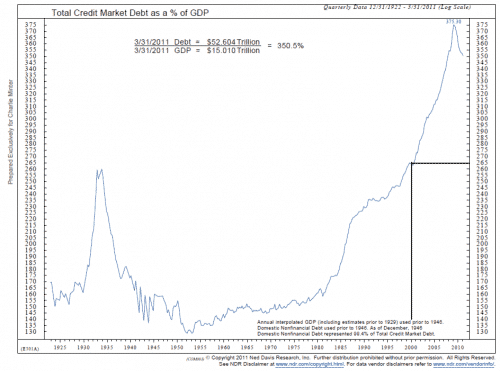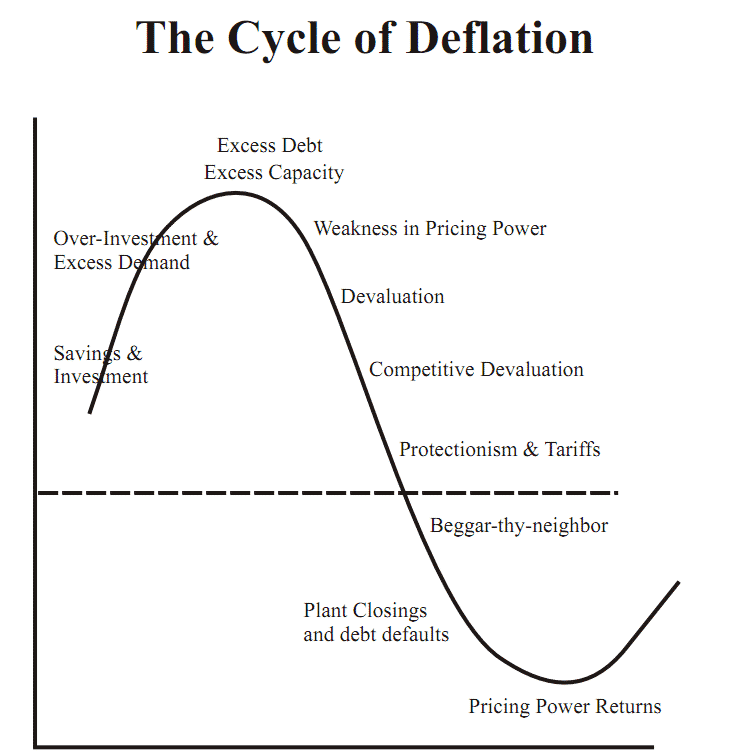Debt is the Problem and Private Debt is Even More of a Problem
By Comstock Partners
As many of you know our fund is currently positioned to benefit from a declining stock market. This bearishness is mostly due to the enormous debt built up over the last few decades (total debt-including private debt– was $11 trillion in 1984 and grew by over $40 trillion to over $52 trillion today). Of that $40 trillion increase over 27 years, $26 trillion came in the last decade.
In fact, the eight years between 2000 and 2008 the debt grew from $26.5 trillion (265% of $10 tn GDP) to $54.5 trillion (or $28 trillion from 2000 to 2008). This was mostly due to the Democratic Congress and Republican Administration where both did whatever possible to convince lenders and households to get everyone into a house whether they could afford it or not. It was a race to see which Party could get the most amount of people into homes they couldn’t afford so they could live the "American Dream." We can’t leave out the significant role of the regulators, Wall Street packaging and selling toxic mortgages to their clients, and rating agencies in this fiasco. There was also a matter of getting involved in two wars and Medicare D (prescription drugs) without figuring out how to finance them. Instead of figuring out ways to finance this additional spending, taxes were actually CUT twice.
The private sector debt that grew the most was the household debt, mostly because of the massive purchases of homes and goods imported largely from emerging economies. This sector of debt was historically about 50% of GDP and 65% of Disposable Personal Income, but by the mid 1980s it starting growing exponentially until it was in a full blown debt bubble. This sector debt rose from $6.5 trillion in 2000 to almost $15 trillion in 2008. This sector is presently deleveraging and is down to about $13 trillion on its way to below $10 trillion (in our opinion) as the deleveraging continues to take a toll on the U.S. (as well as the global economy, since the rest of the world needs U.S. consumption). This is very similar to what took place in Japan starting at the end of 1989 (except that the bubble in Japanese debt resided in the non-financial corporate sector).
Currently, most observers are much more focused on GOVERNMENT DEBT where the debt ceiling was $6 trillion in mid 2002 and just recently President Obama signed a bill lifting the debt ceiling by $2.1 trillion to $16.4 trillion. If you count the unfunded liabilities (or the promises we made to retirees) this debt could be higher than $100 trillion. We believe this debt will have to be addressed thru either inflation (printing our way out at the expense of the U.S. Dollar), or deflating our way out through deleveraging or defaulting on the enormous debt (we believe the deflationary solution to be the highest probability, at least initially). It is very difficult to inflate out of our present situation since banks will only lend to the best credits and the best credits don’t want to take on more debt—this is called a "liquidity trap" and stifles the "velocity of money."
The problem with all of the above solutions is that they will not be easy to resolve since the government sector debt will have to grow to replace the private debt declines, in order to curtail the collapse of the economy. This is exactly what happened in Japan as their government debt grew to 225% of their GDP as the private debt declined in the deflation. We expect the solution that will evolve in this country will start with deflation. We will show exactly how we view deflation by displaying the chart "Cycle of Deflation" (see attachment) which we have used in many prior reports. As you can see, before the tremendous defaults take place there will be massive competitive devaluations bordering on "currency wars" in order to keep the respective economies afloat as they try to export their way out of their declining economies. The Brazilian Foreign Minister has recently discussed the danger of capital controls. Japan just yesterday initiated a 100 billion Yen loan program to weaken the Japanese Yen. Japan, the U.S., the Euro Zone, and even Switzerland are doing whatever they can to debase their currency in order to export their goods and services to their trading partners (the weaker the currency the cheaper their goods and services are to export to their trading partners).
We expect the current "competitive devaluations" to continue for the next year or so, however they cannot continue indefinitely. The countries in the most trouble will not be able to devalue as fast as they would like to, and eventually, the "competitive devaluations" will evolve into Protectionism and Tariffs, then Beggar thy Neighbor policies (selling goods and services below cost to keep plants open), and eventually Plant Closings and Debt Defaults (as we work down the Cycle of Deflation.)
The stock market seemed to rally on better news in a FDIC report and better Durable Goods Orders. However, the FDIC news was not all good since it showed the deposits and reserves increasing, but there was weak credit demand which uncovered the weakness in the overall economy. The Durable Goods Orders ex-defense and transportation was actually down. We don’t think these two releases were the actual reasons for the stock market rise. This market was very oversold early this week and we expect it to have strong rallies within the secular bear market we discuss constantly (see in special reports "Why We Believe We are in a Secular Bear Market" 6/16/2011). We encourage you to sell these rallies. We don’t expect the S&P 500 to rise above the breakdown price of about 1250 since this old support has now turned into significant resistance.


No growth engines, jobs to pay down this private debt either. Like being saddled with tremendous extra weight with very few methods to remove it
Perhaps everyone that took on that debt should have thought about the ramifications before they took it on? Throughout the past several decades I watched as my neighbors took vacations on credit, flipped houses and used the proceeds for cars and other “consumables”. I knew this day was coming, but never in a million years would have believed that people like you would feel sorry for the irresponsible parasites that have brought our country to its knees.
The bottom line is to prevent this future behavior, those who borrowed should have to repay—-those who made risky bets should have to pay—-those who were responsible should be rewarded. How can anyone in good conscious believe any different? Is our that country so morally bankrupt that people actually believe the parasites should be rewarded at the expense of the responsible? IF that is the case, there truly is no hope for this country.
Your point about the banking system being limited by a liquidity trap is well taken. But let’s consider an alternative approach that the Gov’t could use …. one that would stimulate inflation and bypass the banking system entirely.
Hypothetically, let’s suppose the US Treasury decided to implement a “Buyback Program for Peanut Butter”. I’m just picking a common household item – like peanut butter – as an example. But it could be any commodity. The Treasury would actually go out into the real US economy and buy up all the jars of peanut butter. Then it would store them in a big warehouse (maybe they could be given to homeless people at a later time). This would automatically inject a stimulus directly into the American economy – more people who work in food production & supermarkets would benefit. And they would pass their profits on to other sectors. Where does the Treasury get the money to do this? They create new debt, which is bought and monetized by the Fed. Hence in this example we would literally have “money printing” flowing directly into the real economy.
It’s not a scenario that anybody wants to see happen, because it’s highly inflationary and it wreaks of “desperate measures”. But it could be done. And it would inject printed money directly into the real economy, bypassing the financial and banking sectors.
I have no idea whether this kind of stimulus would be legal … but who has stopped them up to now? So the point is – extraordinary means exist to inject inflation into the real economy. Crazy as it may sound, it avoids the problem of adjusting tax rates (not popular), or creating more Gov’t jobs (although some extra warehouses would be needed).
Just my $0.02.
PeteCA
PeteCA, your idea is theft, plain and simple. Put another way, what you are encouraging is for the establishment to reward consumers, bankers, and the irresponsible (a.k.a. parasites) at the expensive of the responsible (a.k.a. intelligent people). While I recognize that the parasites in the U.S. far outnumber the intelligent, the fact is if parasites are not made to pay for their mistakes, they will just do it again. In the end, what you are encouraging is more “cleaning the deck” and encouraging more irresponsible behavior.
Let the irresponsible parasites pay for their mistakes and rewarded the responsible—IOW, reward producers, not consumers, and you fix the problem.